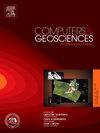Spatial bagging for predictive machine learning uncertainty quantification
IF 4.4
2区 地球科学
Q1 COMPUTER SCIENCE, INTERDISCIPLINARY APPLICATIONS
引用次数: 0
Abstract
Uncertainty quantification is a critical component in the interpretation of spatial phenomena, particularly within the geosciences, where incomplete subsurface data leads to various possible scenarios, making it crucial for risk assessment and decision-making. Traditional geostatistical methods have served as the cornerstone for uncertainty analysis; however, the incorporation of machine learning, particularly ensemble methods, offers a compelling augmentation, especially in handling complex and noisy datasets. Building on our previous work, which introduced a spatial bagging technique for enhancing prediction accuracy, this study extends the method to uncertainty quantification by applying a widely-used UQ metric from geostatistics.
Our approach employs a bootstrap method adjusted for effective sample size derived from spatial statistics, addressing the common issue of overfitting when dealing with dependent data. We demonstrate, through a series of synthetic datasets with varied noise levels and spatial structures, that our spatial bagging method not only outperforms standard bagging techniques in prediction accuracy but also provides superior uncertainty quantification. The robustness of the method against noise and its computational efficiency, particularly in spatially correlated data, positions it as a promising tool for geoscientists and others who require reliable uncertainty measures in spatial analysis.
预测机器学习不确定性量化的空间套袋
不确定性量化是空间现象解释的关键组成部分,特别是在地球科学领域,不完整的地下数据导致各种可能的情况,使其对风险评估和决策至关重要。传统的地质统计学方法是不确定性分析的基础;然而,机器学习的结合,特别是集成方法,提供了一个令人信服的增强,特别是在处理复杂和嘈杂的数据集方面。在我们之前的工作的基础上,引入了空间套袋技术来提高预测精度,本研究通过应用地质统计学中广泛使用的UQ度量,将该方法扩展到不确定性量化。我们的方法采用了一种自举方法,根据空间统计数据调整有效样本量,解决了处理相关数据时过拟合的常见问题。我们通过一系列具有不同噪声水平和空间结构的合成数据集证明,我们的空间套袋方法不仅在预测精度上优于标准套袋技术,而且还提供了优越的不确定性量化。该方法对噪声的鲁棒性及其计算效率,特别是在空间相关数据中,使其成为地球科学家和其他在空间分析中需要可靠不确定性测量的人的有前途的工具。
本文章由计算机程序翻译,如有差异,请以英文原文为准。
求助全文
约1分钟内获得全文
求助全文
来源期刊

Computers & Geosciences
地学-地球科学综合
CiteScore
9.30
自引率
6.80%
发文量
164
审稿时长
3.4 months
期刊介绍:
Computers & Geosciences publishes high impact, original research at the interface between Computer Sciences and Geosciences. Publications should apply modern computer science paradigms, whether computational or informatics-based, to address problems in the geosciences.
 求助内容:
求助内容: 应助结果提醒方式:
应助结果提醒方式:


